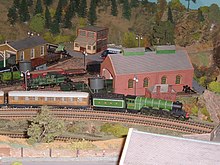OO gauge
[3] This combination came about as early clockwork mechanisms and electric motors were difficult to fit within HO scale models of British trains, which are smaller than their European and North American counterparts.Trix decided to use the new HO standard, being approximately half of European 0 gauge (1:43 scale).In 1938, the Meccano Company launched a new range of OO models under the trade name of Hornby Dublo.Soon other companies followed but it did not prove popular and remained on the market only until 1942, when Lionel train production was shut down due to wartime restrictions to the use of steel.OO remains the most popular scale for railway modelling in Great Britain due to a ready availability of ready-to-run stock and starter sets.Other scales, with the possible exception of N gauge, lack the variety and affordability of UK ready-to-run products.


American wire gaugeBritish Rail Class 25Scale ratioStandard gaugemodel railway4 mm-scaleHO scaleScalefourHornby RailwaysFlying Scotsman locomotiveMeccanoHornby DubloLionel CorporationBachmann BranchlineHeljanTri-ang RailwaysMainline RailwaysN gaugeEMD Class 66weatheringfinescale standardsP4 standardspointworkRail transport modelling scalesAirfixHattons Model RailwaysKitmasterScale modellingAircraftArchitecturalConstructionDioramaDollhouseFigureActionMilitaryRocketRailwayWargamingDiecastMatchstickPlasticStandard gauge railway scalesT gaugeZ scaleN scaleTT scaleOO scaleProtofourS scaleG scaleO scale1 scaleNarrow gauge railway scalesH0e scaleH0m scaleV scaleList of brandsGundamKitbashingMiniature artMiniature modelPort RevelRoom boxDiecast CollectorMeccano Magazine